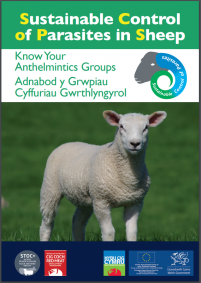- Home
- Resources
- Animal Health and Welfare
- Animal Health Guides
- Anthelmintic Resistance
Anthelmintic Resistance
Internal Parasite control is essential for any livestock production system. High internal parasite burdens can decrease live-weight gain, increase mortality, decrease overall production and reduce the efficiency of the business.
Control methods include grazing management, vaccination, genetic approaches and chemical treatments including anthelmintics. Anthelmintics have been an effective way of controlling worms and fluke for many years. However studies have shown resistance to these medicines is increasing and poses a very real threat to the future of internal parasite control and the livestock industry as a whole.
Resistance means the parasite has developed the ability to survive a dose of anthelmintic which would normally be effective. Here are five factors that affect the speed of developing resistance:
- Proportion of resistant worms on a farm
- Frequency of anthelmintic use
- Efficacy of each treatment
- Proportion of the total worm population in the animal
- Dilution of resistant worms that survive treatment with susceptible worms
Currently there are 5 groups of anthelmintics for the control of worms, 1-BZ (white) group, 2-LV (Yellow), 3-ML (clear), 4-AD (orange) and a 5th group 5-SI (purple). Resistance to 1-BZ group is widespread and a significant increase has been found in both the 2-LV and 3-ML groups in recent studies.
It is not too late to slow down the development of resistance if the right strategy is adopted now!
SCOPS (Sustainable control of parasites in Sheep) an industry led group that recognises if left unchecked, anthelmintic resistance is one of the biggest challenges to the future health and profitability of the UK sheep industry. SCOPS guidelines are an essential aid to the successful and sustainable management of parasites for any sheep system.
COWS (Control of Worms Sustainably) are an industry stakeholder group which aims to promote best practice in the control of cattle parasites. The group have available the guidelines on how to sustainably control fluke and worms in cattle, learning from the increasing resistance in sheep drenches.
In 2014 HCC commissioned the WAARD (Wales Against Anthelmintic Resistance Development) project. The project ran from September 2014 – July 2015. It was funded through the Rural Development Plan for Wales 2007 – 13. It looked at 47 Welsh farms and the effectiveness of four types of wormer: Benzimidazole (1-BZ); Levamisole (2-LV); Ivermectin (3-ML) and Moxidectin (3-ML).
It revealed:
- One farm only showed that all drugs were still fully effective on that farm;
- 94% of farms have evidence of resistance to Benzimidazole;
- 68% of farms have evidence of resistance to Levamisole;
- 51% of farms have evidence of resistance to Ivermectin;
- 19% of farms have evidence of resistance to Moxidectin.
Interestingly the one farm in which all drugs were still effective, had been following SCOPS guidelines for some years.
For full details see the report: WAARD Project - Final Report (September 2015)


